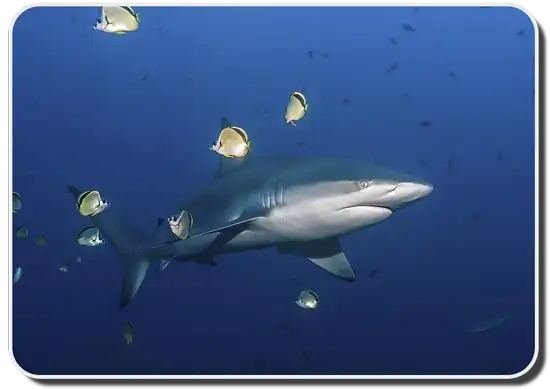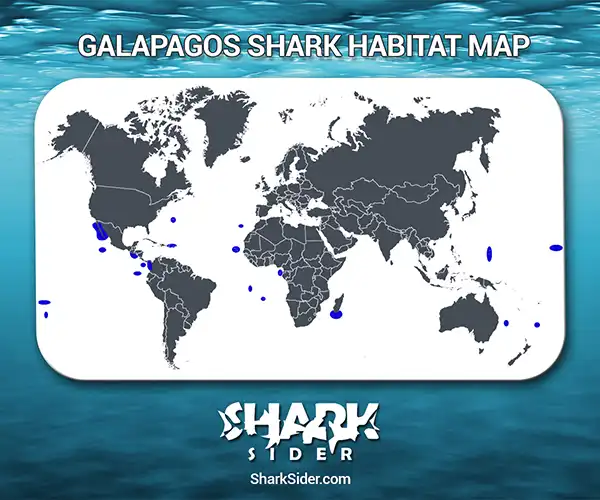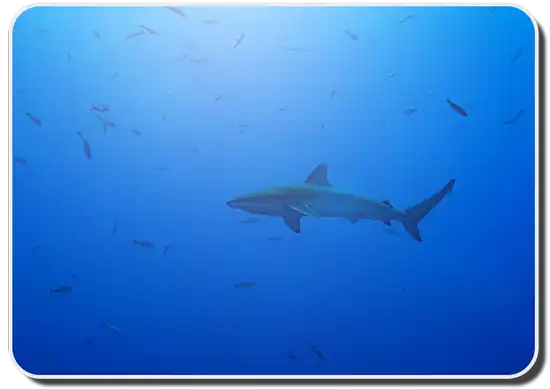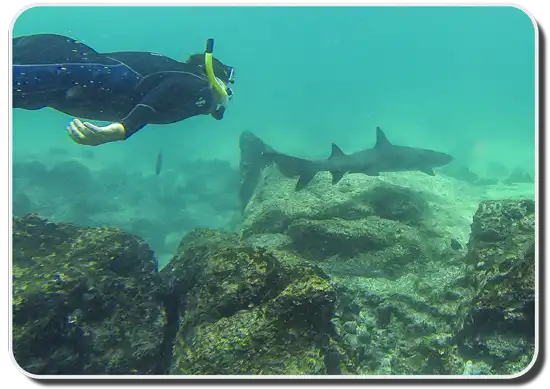Galapagos sharks are found not only in the Galapagos Islands, as their name suggests but throughout the world. They are requiem sharks similar to the black tip reef and dusky sharks, distinguished from the others with their tall and round first dorsal fin.
These sharks sometimes eat their young, requiring the two to stay separately from birth.

Galapagos Shark Scientific Classification |
|
| Kingdom | Animalia |
| Phylum | Chordata |
| Class | Chondrichthyes |
| Order | Carcharhiniformes |
| Family | Carcharhinidae |
| Genus | Carcharhinus |
| Scientific Name | C. galapagensis |
Description
These sharks are 9.8-11.5 ft and weigh up to 430 lbs. They have streamlined bodies, with a rounded, broad snout and medium round eyes. They have 14 rows of teeth on both jaws, plus one tooth where the jaw halves meet. However, there is a difference as the upper teeth are stout and triangular, while the lower teeth are narrower, though both have serrated edges.
The first dorsal fin is opposite the pair of pectoral fins and is around half the length. They are brownish-grey dorsally and white ventrally, with a white band sometimes seen on the flanks.
Where do they live
Map Of The Galapagos Shark’s Habitat

The Galapagos shark is found close to tropical islands in three major oceans. In the Atlantic, it is seen around Ascension Island, Bermuda, Cape Verde, Madeira, Saint Helena, São Tomé Island, and the Virgin Islands. In the Pacific, Clipperton Island, Cocos Island, the Galapagos Islands, the Hawaiian Islands, the Juan Fernández Islands, the Kermadec Islands, Lord Howe Island, Malpelo, the Marianas Islands, the Marshall Islands, the Revillagigedo Islands, the Tuamotu Archipelago, and Tupai all fall under its range. While in the Indian Ocean, these sharks range from Walter’s Shoal off southern Madagascar. Individual specimens have been spotted in Baja California, Colombia, eastern Australia, Guatemala, and the Iberian Peninsula.
Interestingly, this shark strongly prefers open waters with strong currents. However, it is found in both inshore and offshore areas as well. The juveniles stay in shallower waters to steer clear of adults.

Behavior
Dietary
Most of these sharks’ diet consists of bony fish and cephalopods, but some larger sharks will consume crustaceans, iguanas, sea lions, and other sharks, including members of their species.
Predatory
They are very active predators and attack anything that looks like a meal.
Defensive
If threatened, a Galapagos shark will arch its back, lower its pectoral fins, and swim in a twisting motion in figure-eight loops. Even after this display, if the shark continues to be disturbed, it will pursue the intruder and rush at them.
Social
While they are primarily solitary, they sometimes form aggregations in some areas. However, these are not actual “schools”.
Migratory
Galapagos sharks can cross large distances, traveling to deeper parts of the oceans during winter.
Reproductive
During courtship, males bite females, which leaves behind scars sometimes on their bodies. The reproductive process is viviparous, meaning after a gestation period of a year, a female gives birth to 4-16 pups in shallow waters. These sharks’ reproduction rate is relatively low, as they give birth once every 2-3 years.
Initially, the babies are 1.87-2.62 ft long. When they are sexually mature the males are 6.9–8.2 ft and 6–8 years of age and the females are 7.2–8.2 ft and 7–9 years. The juveniles themselves will begin to reproduce at 10 years of age and can live up to at least 24 years.
Adaptations
The Galapagos shark has a unique ability – when it ends up swallowing something it shouldn’t have, it will eject its entire stomach with all its contents and then suck it back in.
Interactions with humans
These sharks can potentially threaten humans, becoming quite dangerous in certain situations. They usually do not attack and ignore a human presence, but fishers have noted that sometimes when hauling in their catch, these sharks will show up to feed. Any attempt to deter them will cause the shark to become more excited, with even repellents not working on them. Attacking them with weapons during this time might whip them into a feeding frenzy.

There have been three confirmed Galapagos shark attacks until 2008, with two of them being fatal in the Virgin Islands. The third victim, attacked off the coast of Bermuda, survived. However, despite the risks, tourists will sometimes dive underwater to swim with these sharks; though having an experienced guide alongside them is recommended.
The IUCN classifies the Galapagos shark as “Least Concern” or “LC”, though there are some concerns due to its low birth rate and risk of infant cannibalization. The Department of Conservation of New Zealand classifies this shark as “Not Threatened” under their Threat Classification System. However, they have added the qualifiers “Conservation Dependent” and “Secure Overseas”.
